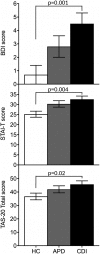Low Plasma Oxytocin Levels and Increased Psychopathology in Hypopituitary Men With Diabetes Insipidus
- PMID: 30882859
- PMCID: PMC6570634
- DOI: 10.1210/jc.2018-02608
Low Plasma Oxytocin Levels and Increased Psychopathology in Hypopituitary Men With Diabetes Insipidus
Abstract
Context: Oxytocin (OT) and vasopressin share anatomical pathways of synthesis and secretion, and patients with central diabetes insipidus (CDI) presumably are at risk for OT deficiency. However, an OT-deficient state in hypopituitary patients has not been established.
Objectives: We hypothesized that men with CDI compared to patients with similar anterior pituitary deficiencies (APD) but no CDI and healthy controls (HC) of similar age and body mass index, would have lower plasma OT levels, associated with increased psychopathology.
Design: Cross-sectional.
Setting: Clinical research center.
Participants: Sixty-two men (20 CDI, 20 APD, 22 HC), age 18 to 60 years.
Interventions: Frequent sampling of blood every 5 minutes for OT over 1 hour and validated questionnaires to assess psychopathology.
Main outcomes: Pooled plasma OT levels; depressive, anxiety, and alexithymia symptoms; and quality of life.
Results: The mean 1-hour pool of fasting OT levels was lower in CDI compared with APD and HC (P = 0.02 and P = 0.009, respectively), with no differences between APD and HC (P = 0.78). Symptoms of depression, anxiety, and alexithymia were more pronounced in CDI than in HC (P = 0.001, P = 0.004, and P = 0.02, respectively). Although CDI and APD reported worse physical health compared with HC (P = 0.001 and P = 0.005) with no differences between APD and CDI, only CDI reported worse mental health compared with HC (P = 0.009).
Conclusions: We have demonstrated low plasma OT levels and increased psychopathology in hypopituitary men with CDI, suggestive of a possible OT-deficient state. Larger studies of both sexes are required to confirm these findings and clinically characterize hypopituitary patients with OT deficiency.
Copyright © 2019 Endocrine Society.
Figures



References
-
- Fleseriu M, Hashim IA, Karavitaki N, Melmed S, Murad MH, Salvatori R, Samuels MH. Hormonal replacement in hypopituitarism in adults: an Endocrine Society clinical practice guideline. J Clin Endocrinol Metab. 2016;101(11):3888–3921. - PubMed
-
- Regal M, Páramo C, Sierra SM, Garcia-Mayor RV. Prevalence and incidence of hypopituitarism in an adult Caucasian population in northwestern Spain. Clin Endocrinol (Oxf). 2001;55(6):735–740. - PubMed
-
- Molitch ME, Clemmons DR, Malozowski S, Merriam GR, Vance ML, Endocrine S; Endocrine Society. Evaluation and treatment of adult growth hormone deficiency: an Endocrine Society clinical practice guideline. J Clin Endocrinol Metab. 2011;96(6):1587–1609. - PubMed
-
- Ospina NS, Al Nofal A, Bancos I, Javed A, Benkhadra K, Kapoor E, Lteif AN, Natt N, Murad MH. ACTH stimulation tests for the diagnosis of adrenal insufficiency: systematic review and meta-analysis. J Clin Endocrinol Metab. 2016;101(2):427–434. - PubMed
-
- Bhasin S, Brito JP, Cunningham GR, Hayes FJ, Hodis HN, Matsumoto AM, Snyder PJ, Swerdloff RS, Wu FC, Yialamas MA. Testosterone therapy in men with hypogonadism: an Endocrine Society clinical practice guideline. J Clin Endocrinol Metab. 2018;103(5):1715–1744. - PubMed
Publication types
MeSH terms
Substances
Grants and funding
LinkOut - more resources
Full Text Sources
Other Literature Sources
Medical

